UUIS8000 Global Information Systems: ANZ Bank Big Data Strategy
VerifiedAdded on 2022/10/08
|18
|5384
|17
Report
AI Summary
This report provides a comprehensive analysis of the ANZ Bank's current IT infrastructure, identifying both its strengths and weaknesses. The report delves into the challenges the bank faces in managing its IT infrastructure, including issues related to computing platforms, data acquisition, data storage, and data analytics. It then explores emerging technologies, with a particular focus on data analytics as a strategic solution for the bank. The report provides an overview of big data, its potential, and its utilization by businesses, including the opportunities and benefits it offers, as well as its drawbacks. The report recommends the implementation of a big data strategy for the ANZ Bank, emphasizing the importance of data analytics in predicting customer behavior, improving services, enhancing customer experience, and gaining a competitive edge. The report concludes by highlighting the future of big data and its significance for the bank's success.
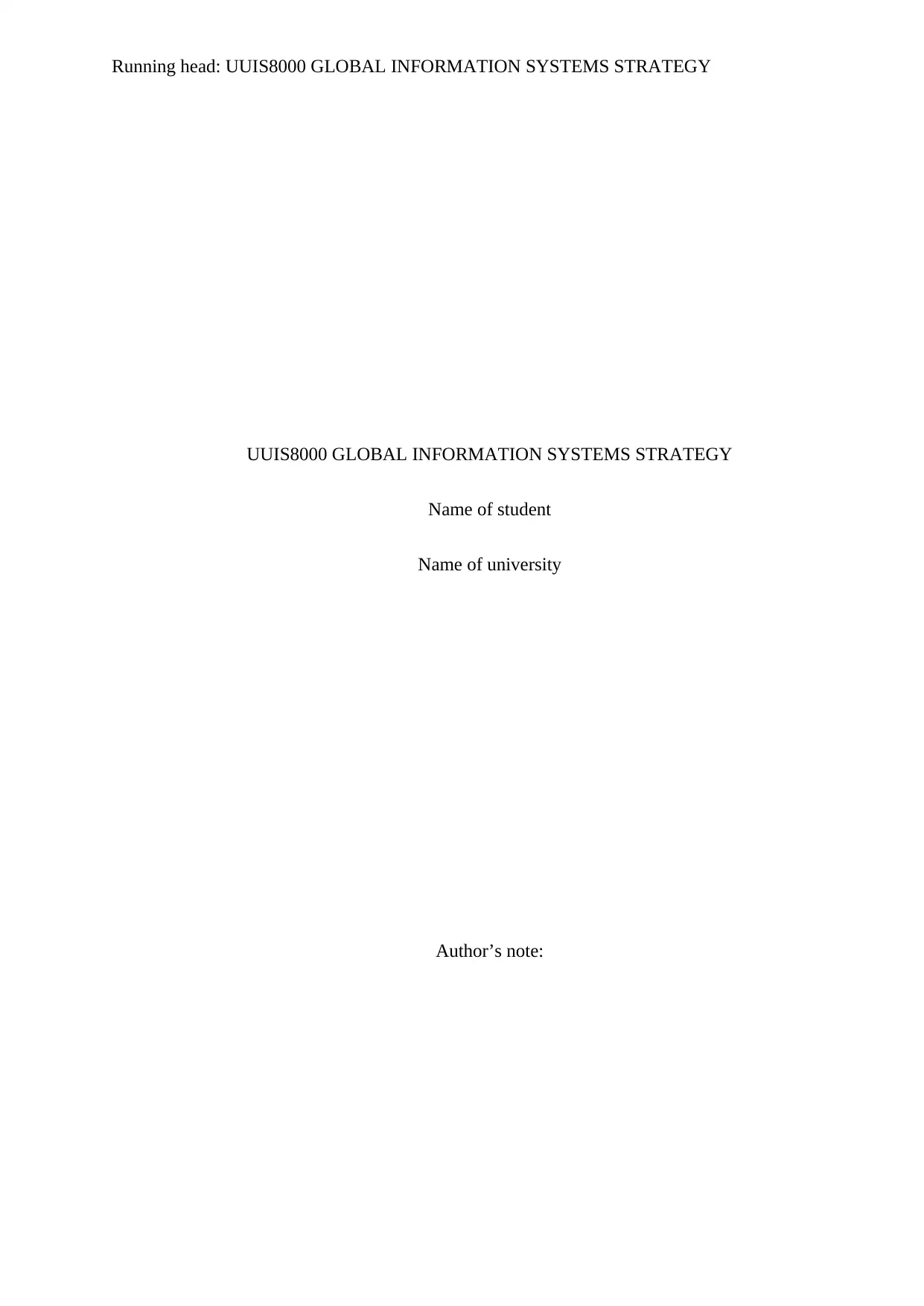
Running head: UUIS8000 GLOBAL INFORMATION SYSTEMS STRATEGY
UUIS8000 GLOBAL INFORMATION SYSTEMS STRATEGY
Name of student
Name of university
Author’s note:
UUIS8000 GLOBAL INFORMATION SYSTEMS STRATEGY
Name of student
Name of university
Author’s note:
Paraphrase This Document
Need a fresh take? Get an instant paraphrase of this document with our AI Paraphraser
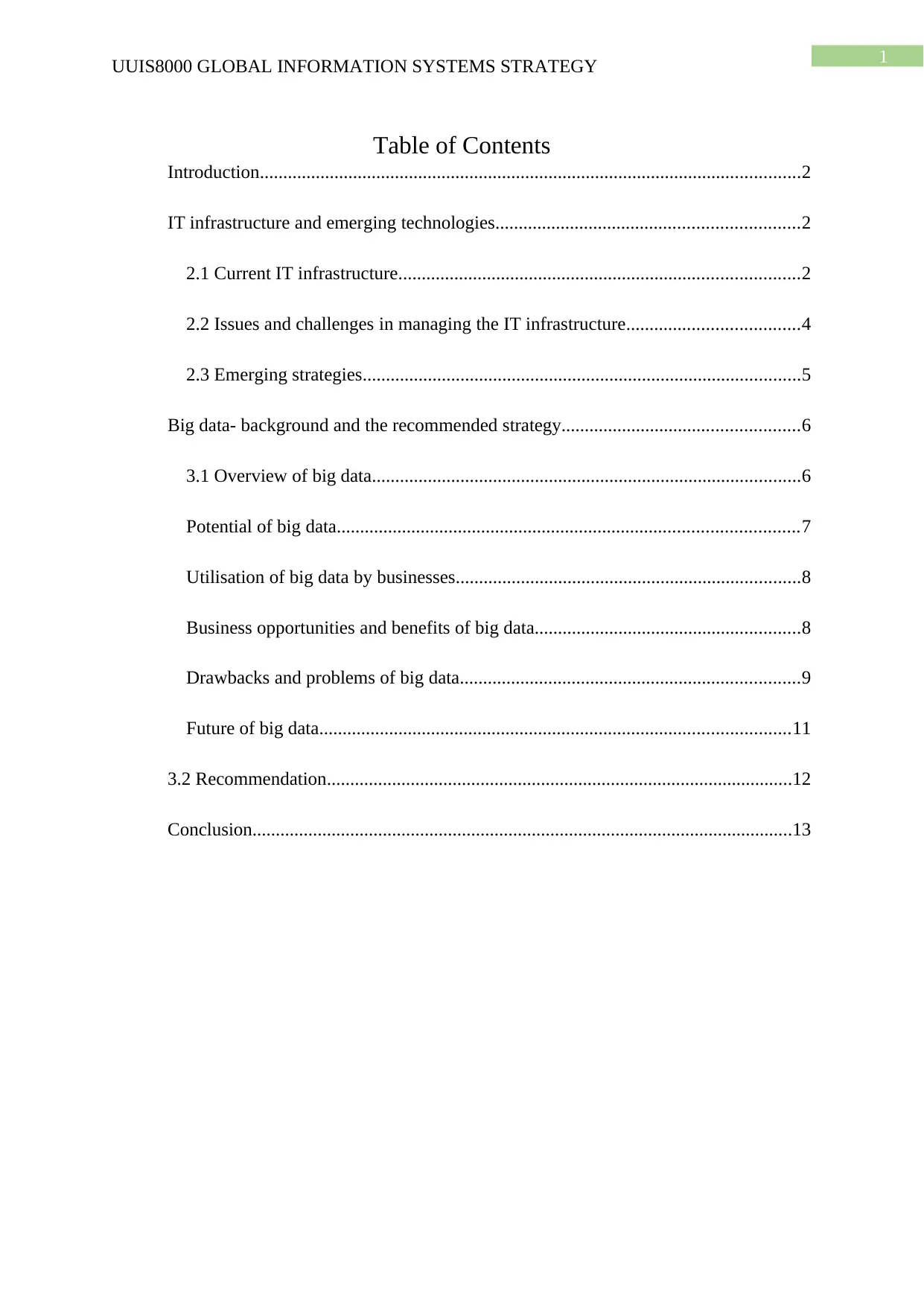
1
UUIS8000 GLOBAL INFORMATION SYSTEMS STRATEGY
Table of Contents
Introduction....................................................................................................................2
IT infrastructure and emerging technologies.................................................................2
2.1 Current IT infrastructure......................................................................................2
2.2 Issues and challenges in managing the IT infrastructure.....................................4
2.3 Emerging strategies..............................................................................................5
Big data- background and the recommended strategy...................................................6
3.1 Overview of big data............................................................................................6
Potential of big data...................................................................................................7
Utilisation of big data by businesses..........................................................................8
Business opportunities and benefits of big data.........................................................8
Drawbacks and problems of big data.........................................................................9
Future of big data.....................................................................................................11
3.2 Recommendation....................................................................................................12
Conclusion....................................................................................................................13
UUIS8000 GLOBAL INFORMATION SYSTEMS STRATEGY
Table of Contents
Introduction....................................................................................................................2
IT infrastructure and emerging technologies.................................................................2
2.1 Current IT infrastructure......................................................................................2
2.2 Issues and challenges in managing the IT infrastructure.....................................4
2.3 Emerging strategies..............................................................................................5
Big data- background and the recommended strategy...................................................6
3.1 Overview of big data............................................................................................6
Potential of big data...................................................................................................7
Utilisation of big data by businesses..........................................................................8
Business opportunities and benefits of big data.........................................................8
Drawbacks and problems of big data.........................................................................9
Future of big data.....................................................................................................11
3.2 Recommendation....................................................................................................12
Conclusion....................................................................................................................13
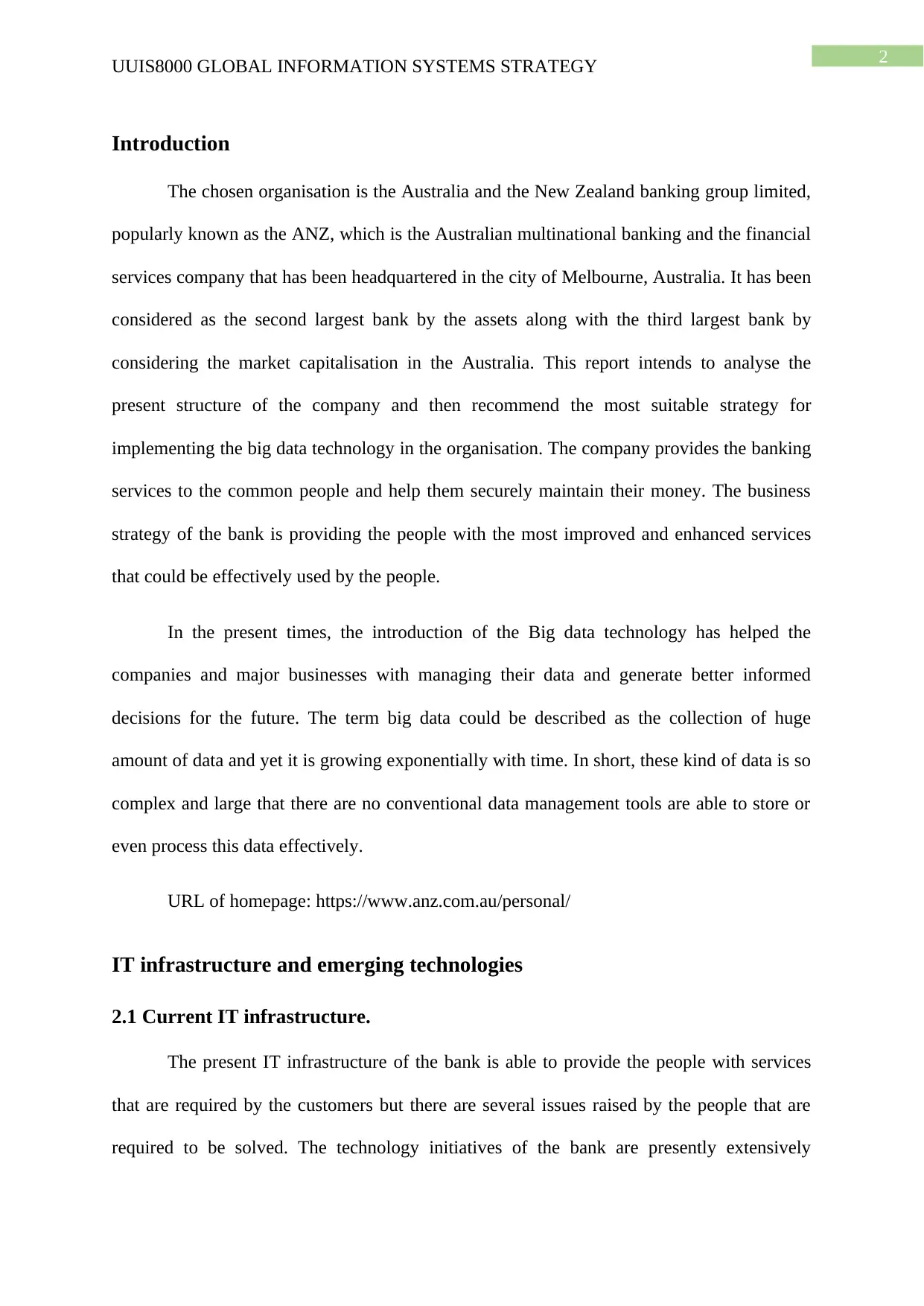
2
UUIS8000 GLOBAL INFORMATION SYSTEMS STRATEGY
Introduction
The chosen organisation is the Australia and the New Zealand banking group limited,
popularly known as the ANZ, which is the Australian multinational banking and the financial
services company that has been headquartered in the city of Melbourne, Australia. It has been
considered as the second largest bank by the assets along with the third largest bank by
considering the market capitalisation in the Australia. This report intends to analyse the
present structure of the company and then recommend the most suitable strategy for
implementing the big data technology in the organisation. The company provides the banking
services to the common people and help them securely maintain their money. The business
strategy of the bank is providing the people with the most improved and enhanced services
that could be effectively used by the people.
In the present times, the introduction of the Big data technology has helped the
companies and major businesses with managing their data and generate better informed
decisions for the future. The term big data could be described as the collection of huge
amount of data and yet it is growing exponentially with time. In short, these kind of data is so
complex and large that there are no conventional data management tools are able to store or
even process this data effectively.
URL of homepage: https://www.anz.com.au/personal/
IT infrastructure and emerging technologies
2.1 Current IT infrastructure.
The present IT infrastructure of the bank is able to provide the people with services
that are required by the customers but there are several issues raised by the people that are
required to be solved. The technology initiatives of the bank are presently extensively
UUIS8000 GLOBAL INFORMATION SYSTEMS STRATEGY
Introduction
The chosen organisation is the Australia and the New Zealand banking group limited,
popularly known as the ANZ, which is the Australian multinational banking and the financial
services company that has been headquartered in the city of Melbourne, Australia. It has been
considered as the second largest bank by the assets along with the third largest bank by
considering the market capitalisation in the Australia. This report intends to analyse the
present structure of the company and then recommend the most suitable strategy for
implementing the big data technology in the organisation. The company provides the banking
services to the common people and help them securely maintain their money. The business
strategy of the bank is providing the people with the most improved and enhanced services
that could be effectively used by the people.
In the present times, the introduction of the Big data technology has helped the
companies and major businesses with managing their data and generate better informed
decisions for the future. The term big data could be described as the collection of huge
amount of data and yet it is growing exponentially with time. In short, these kind of data is so
complex and large that there are no conventional data management tools are able to store or
even process this data effectively.
URL of homepage: https://www.anz.com.au/personal/
IT infrastructure and emerging technologies
2.1 Current IT infrastructure.
The present IT infrastructure of the bank is able to provide the people with services
that are required by the customers but there are several issues raised by the people that are
required to be solved. The technology initiatives of the bank are presently extensively
⊘ This is a preview!⊘
Do you want full access?
Subscribe today to unlock all pages.

Trusted by 1+ million students worldwide
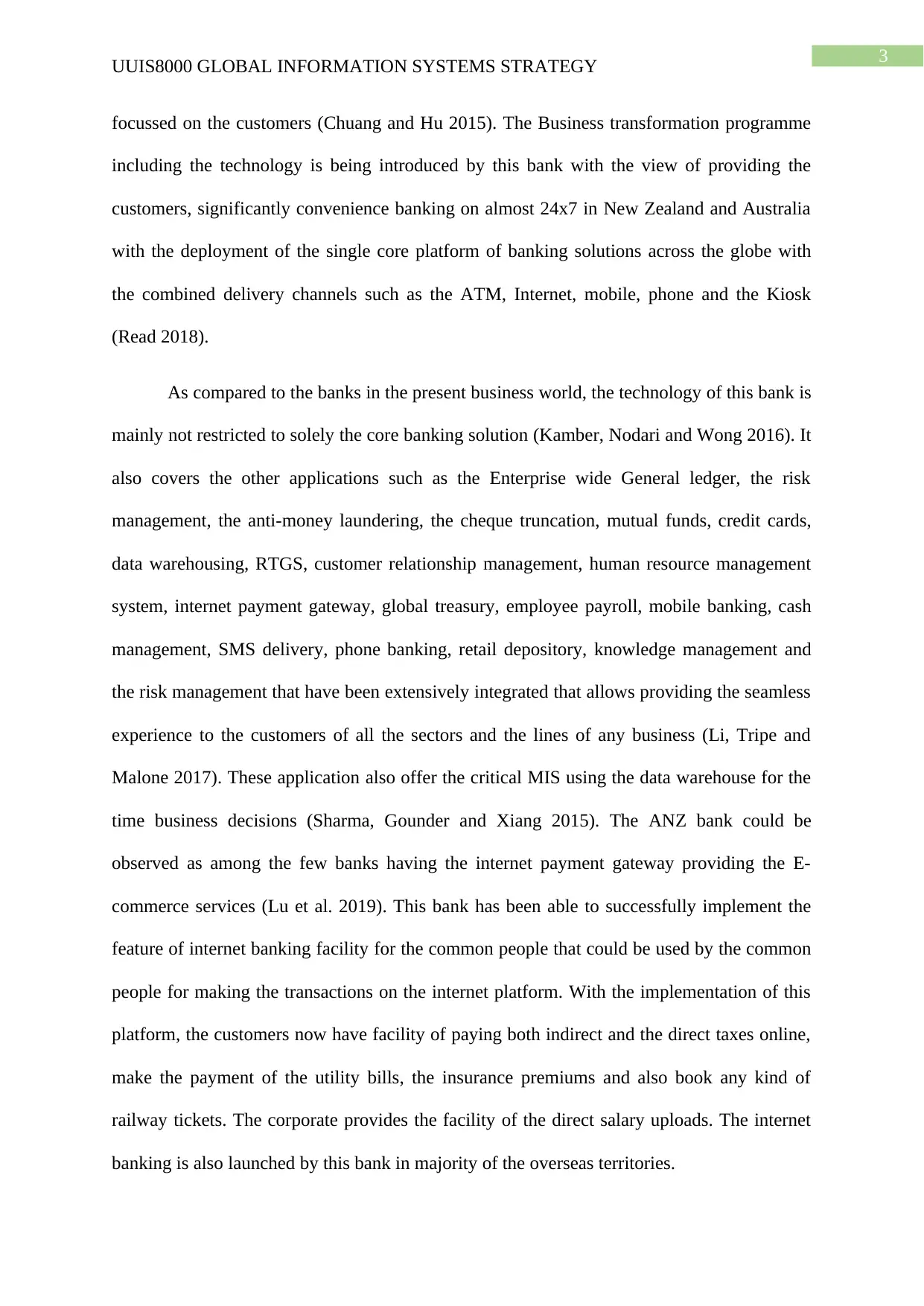
3
UUIS8000 GLOBAL INFORMATION SYSTEMS STRATEGY
focussed on the customers (Chuang and Hu 2015). The Business transformation programme
including the technology is being introduced by this bank with the view of providing the
customers, significantly convenience banking on almost 24x7 in New Zealand and Australia
with the deployment of the single core platform of banking solutions across the globe with
the combined delivery channels such as the ATM, Internet, mobile, phone and the Kiosk
(Read 2018).
As compared to the banks in the present business world, the technology of this bank is
mainly not restricted to solely the core banking solution (Kamber, Nodari and Wong 2016). It
also covers the other applications such as the Enterprise wide General ledger, the risk
management, the anti-money laundering, the cheque truncation, mutual funds, credit cards,
data warehousing, RTGS, customer relationship management, human resource management
system, internet payment gateway, global treasury, employee payroll, mobile banking, cash
management, SMS delivery, phone banking, retail depository, knowledge management and
the risk management that have been extensively integrated that allows providing the seamless
experience to the customers of all the sectors and the lines of any business (Li, Tripe and
Malone 2017). These application also offer the critical MIS using the data warehouse for the
time business decisions (Sharma, Gounder and Xiang 2015). The ANZ bank could be
observed as among the few banks having the internet payment gateway providing the E-
commerce services (Lu et al. 2019). This bank has been able to successfully implement the
feature of internet banking facility for the common people that could be used by the common
people for making the transactions on the internet platform. With the implementation of this
platform, the customers now have facility of paying both indirect and the direct taxes online,
make the payment of the utility bills, the insurance premiums and also book any kind of
railway tickets. The corporate provides the facility of the direct salary uploads. The internet
banking is also launched by this bank in majority of the overseas territories.
UUIS8000 GLOBAL INFORMATION SYSTEMS STRATEGY
focussed on the customers (Chuang and Hu 2015). The Business transformation programme
including the technology is being introduced by this bank with the view of providing the
customers, significantly convenience banking on almost 24x7 in New Zealand and Australia
with the deployment of the single core platform of banking solutions across the globe with
the combined delivery channels such as the ATM, Internet, mobile, phone and the Kiosk
(Read 2018).
As compared to the banks in the present business world, the technology of this bank is
mainly not restricted to solely the core banking solution (Kamber, Nodari and Wong 2016). It
also covers the other applications such as the Enterprise wide General ledger, the risk
management, the anti-money laundering, the cheque truncation, mutual funds, credit cards,
data warehousing, RTGS, customer relationship management, human resource management
system, internet payment gateway, global treasury, employee payroll, mobile banking, cash
management, SMS delivery, phone banking, retail depository, knowledge management and
the risk management that have been extensively integrated that allows providing the seamless
experience to the customers of all the sectors and the lines of any business (Li, Tripe and
Malone 2017). These application also offer the critical MIS using the data warehouse for the
time business decisions (Sharma, Gounder and Xiang 2015). The ANZ bank could be
observed as among the few banks having the internet payment gateway providing the E-
commerce services (Lu et al. 2019). This bank has been able to successfully implement the
feature of internet banking facility for the common people that could be used by the common
people for making the transactions on the internet platform. With the implementation of this
platform, the customers now have facility of paying both indirect and the direct taxes online,
make the payment of the utility bills, the insurance premiums and also book any kind of
railway tickets. The corporate provides the facility of the direct salary uploads. The internet
banking is also launched by this bank in majority of the overseas territories.
Paraphrase This Document
Need a fresh take? Get an instant paraphrase of this document with our AI Paraphraser
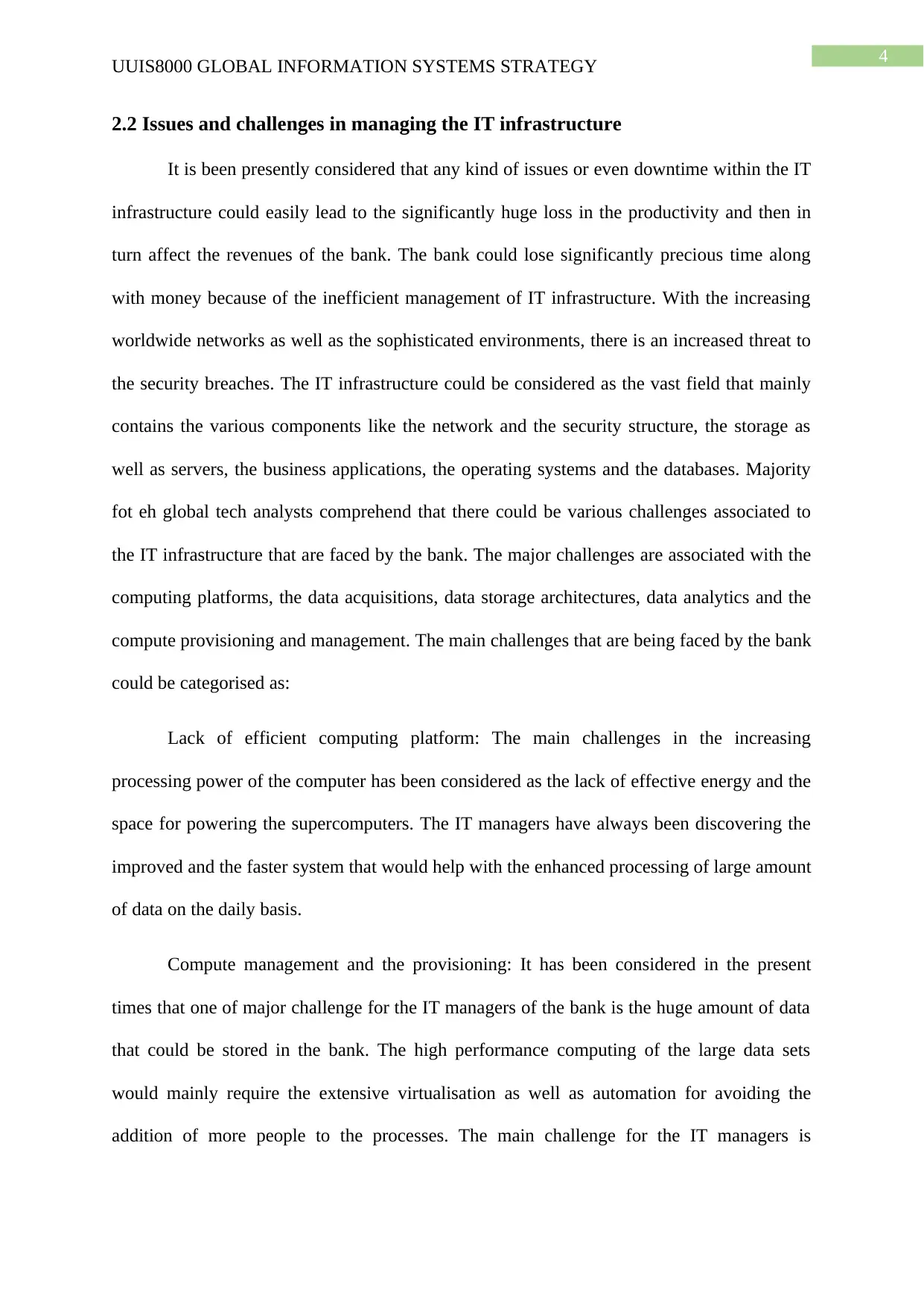
4
UUIS8000 GLOBAL INFORMATION SYSTEMS STRATEGY
2.2 Issues and challenges in managing the IT infrastructure
It is been presently considered that any kind of issues or even downtime within the IT
infrastructure could easily lead to the significantly huge loss in the productivity and then in
turn affect the revenues of the bank. The bank could lose significantly precious time along
with money because of the inefficient management of IT infrastructure. With the increasing
worldwide networks as well as the sophisticated environments, there is an increased threat to
the security breaches. The IT infrastructure could be considered as the vast field that mainly
contains the various components like the network and the security structure, the storage as
well as servers, the business applications, the operating systems and the databases. Majority
fot eh global tech analysts comprehend that there could be various challenges associated to
the IT infrastructure that are faced by the bank. The major challenges are associated with the
computing platforms, the data acquisitions, data storage architectures, data analytics and the
compute provisioning and management. The main challenges that are being faced by the bank
could be categorised as:
Lack of efficient computing platform: The main challenges in the increasing
processing power of the computer has been considered as the lack of effective energy and the
space for powering the supercomputers. The IT managers have always been discovering the
improved and the faster system that would help with the enhanced processing of large amount
of data on the daily basis.
Compute management and the provisioning: It has been considered in the present
times that one of major challenge for the IT managers of the bank is the huge amount of data
that could be stored in the bank. The high performance computing of the large data sets
would mainly require the extensive virtualisation as well as automation for avoiding the
addition of more people to the processes. The main challenge for the IT managers is
UUIS8000 GLOBAL INFORMATION SYSTEMS STRATEGY
2.2 Issues and challenges in managing the IT infrastructure
It is been presently considered that any kind of issues or even downtime within the IT
infrastructure could easily lead to the significantly huge loss in the productivity and then in
turn affect the revenues of the bank. The bank could lose significantly precious time along
with money because of the inefficient management of IT infrastructure. With the increasing
worldwide networks as well as the sophisticated environments, there is an increased threat to
the security breaches. The IT infrastructure could be considered as the vast field that mainly
contains the various components like the network and the security structure, the storage as
well as servers, the business applications, the operating systems and the databases. Majority
fot eh global tech analysts comprehend that there could be various challenges associated to
the IT infrastructure that are faced by the bank. The major challenges are associated with the
computing platforms, the data acquisitions, data storage architectures, data analytics and the
compute provisioning and management. The main challenges that are being faced by the bank
could be categorised as:
Lack of efficient computing platform: The main challenges in the increasing
processing power of the computer has been considered as the lack of effective energy and the
space for powering the supercomputers. The IT managers have always been discovering the
improved and the faster system that would help with the enhanced processing of large amount
of data on the daily basis.
Compute management and the provisioning: It has been considered in the present
times that one of major challenge for the IT managers of the bank is the huge amount of data
that could be stored in the bank. The high performance computing of the large data sets
would mainly require the extensive virtualisation as well as automation for avoiding the
addition of more people to the processes. The main challenge for the IT managers is
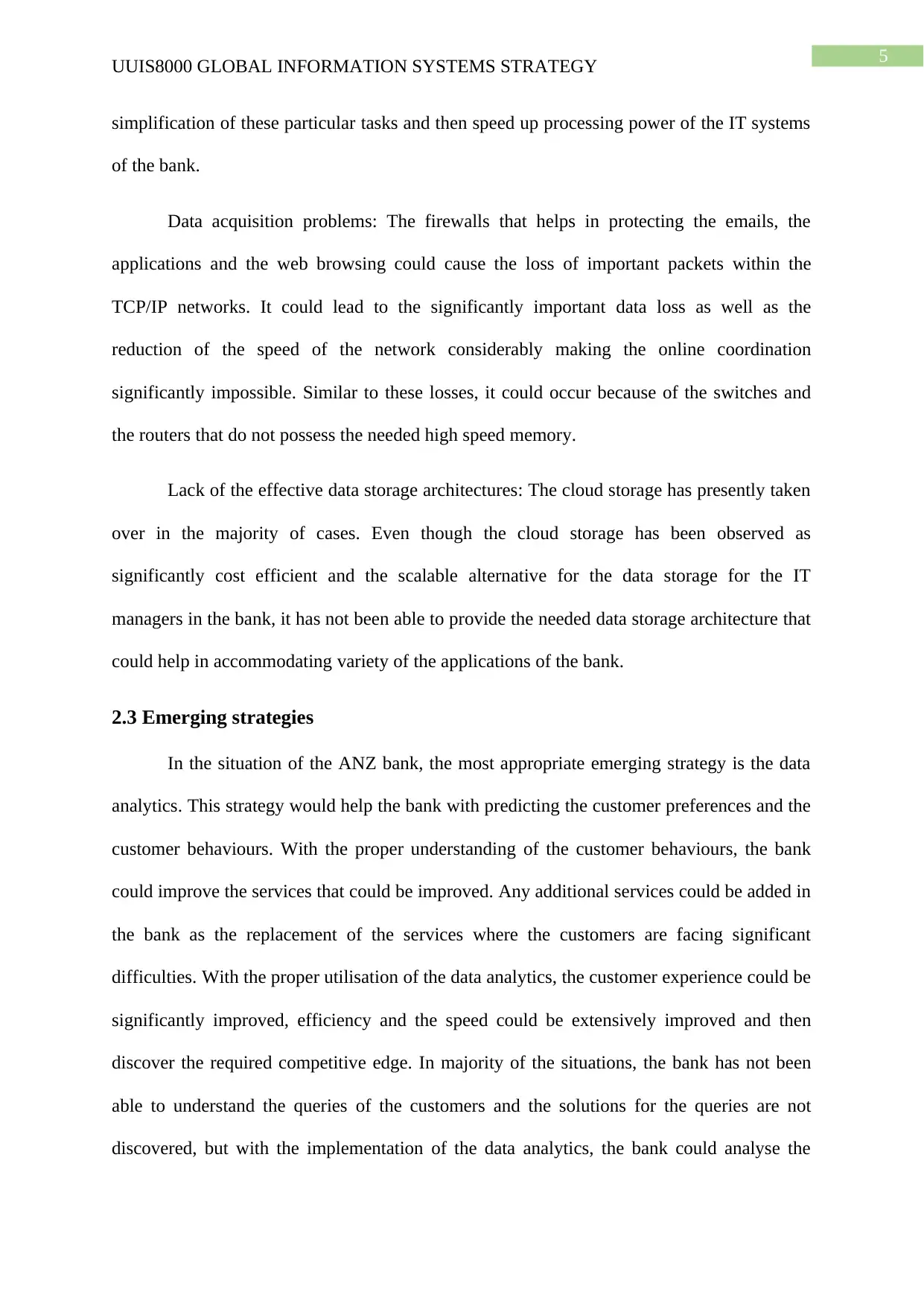
5
UUIS8000 GLOBAL INFORMATION SYSTEMS STRATEGY
simplification of these particular tasks and then speed up processing power of the IT systems
of the bank.
Data acquisition problems: The firewalls that helps in protecting the emails, the
applications and the web browsing could cause the loss of important packets within the
TCP/IP networks. It could lead to the significantly important data loss as well as the
reduction of the speed of the network considerably making the online coordination
significantly impossible. Similar to these losses, it could occur because of the switches and
the routers that do not possess the needed high speed memory.
Lack of the effective data storage architectures: The cloud storage has presently taken
over in the majority of cases. Even though the cloud storage has been observed as
significantly cost efficient and the scalable alternative for the data storage for the IT
managers in the bank, it has not been able to provide the needed data storage architecture that
could help in accommodating variety of the applications of the bank.
2.3 Emerging strategies
In the situation of the ANZ bank, the most appropriate emerging strategy is the data
analytics. This strategy would help the bank with predicting the customer preferences and the
customer behaviours. With the proper understanding of the customer behaviours, the bank
could improve the services that could be improved. Any additional services could be added in
the bank as the replacement of the services where the customers are facing significant
difficulties. With the proper utilisation of the data analytics, the customer experience could be
significantly improved, efficiency and the speed could be extensively improved and then
discover the required competitive edge. In majority of the situations, the bank has not been
able to understand the queries of the customers and the solutions for the queries are not
discovered, but with the implementation of the data analytics, the bank could analyse the
UUIS8000 GLOBAL INFORMATION SYSTEMS STRATEGY
simplification of these particular tasks and then speed up processing power of the IT systems
of the bank.
Data acquisition problems: The firewalls that helps in protecting the emails, the
applications and the web browsing could cause the loss of important packets within the
TCP/IP networks. It could lead to the significantly important data loss as well as the
reduction of the speed of the network considerably making the online coordination
significantly impossible. Similar to these losses, it could occur because of the switches and
the routers that do not possess the needed high speed memory.
Lack of the effective data storage architectures: The cloud storage has presently taken
over in the majority of cases. Even though the cloud storage has been observed as
significantly cost efficient and the scalable alternative for the data storage for the IT
managers in the bank, it has not been able to provide the needed data storage architecture that
could help in accommodating variety of the applications of the bank.
2.3 Emerging strategies
In the situation of the ANZ bank, the most appropriate emerging strategy is the data
analytics. This strategy would help the bank with predicting the customer preferences and the
customer behaviours. With the proper understanding of the customer behaviours, the bank
could improve the services that could be improved. Any additional services could be added in
the bank as the replacement of the services where the customers are facing significant
difficulties. With the proper utilisation of the data analytics, the customer experience could be
significantly improved, efficiency and the speed could be extensively improved and then
discover the required competitive edge. In majority of the situations, the bank has not been
able to understand the queries of the customers and the solutions for the queries are not
discovered, but with the implementation of the data analytics, the bank could analyse the
⊘ This is a preview!⊘
Do you want full access?
Subscribe today to unlock all pages.

Trusted by 1+ million students worldwide
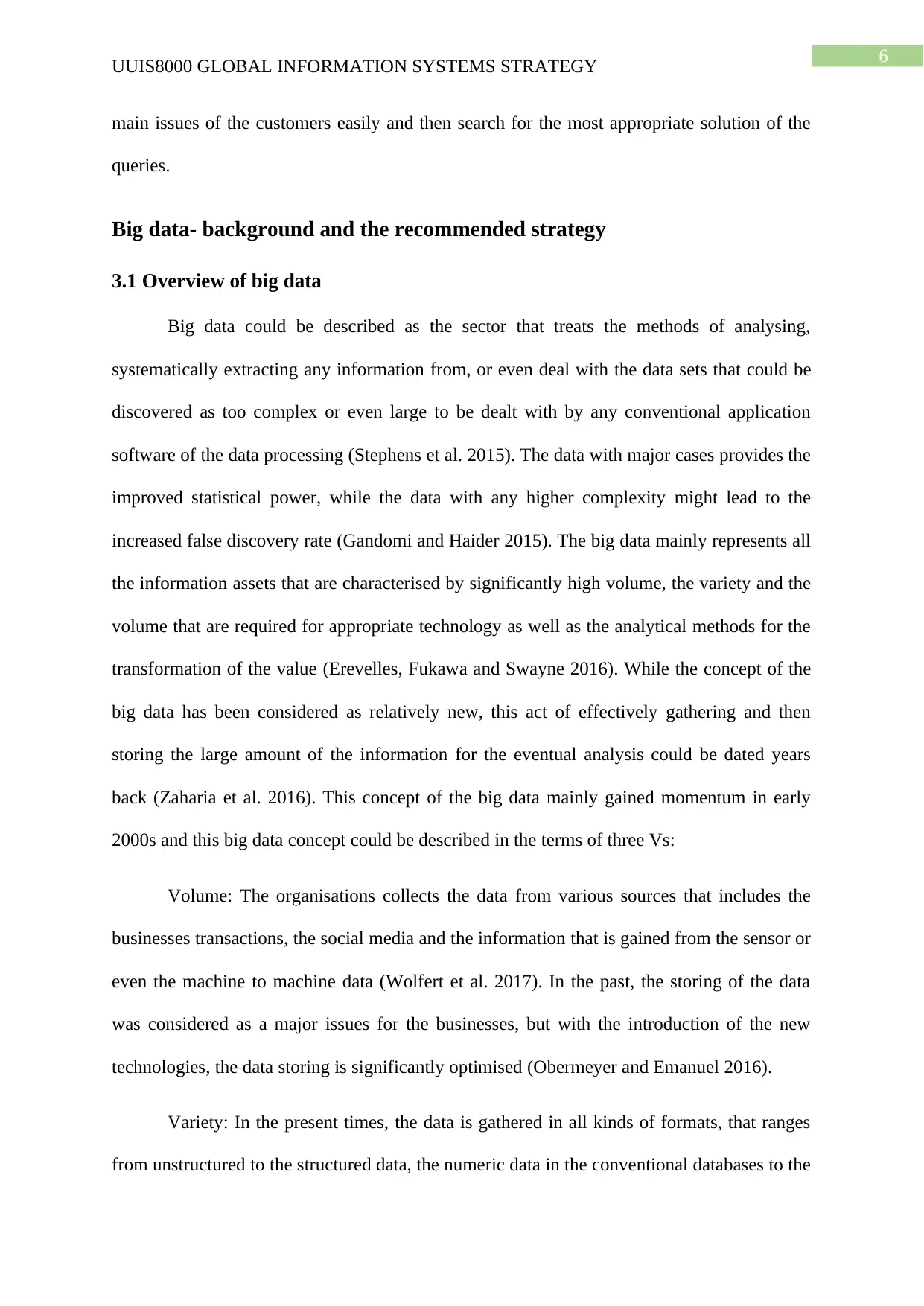
6
UUIS8000 GLOBAL INFORMATION SYSTEMS STRATEGY
main issues of the customers easily and then search for the most appropriate solution of the
queries.
Big data- background and the recommended strategy
3.1 Overview of big data
Big data could be described as the sector that treats the methods of analysing,
systematically extracting any information from, or even deal with the data sets that could be
discovered as too complex or even large to be dealt with by any conventional application
software of the data processing (Stephens et al. 2015). The data with major cases provides the
improved statistical power, while the data with any higher complexity might lead to the
increased false discovery rate (Gandomi and Haider 2015). The big data mainly represents all
the information assets that are characterised by significantly high volume, the variety and the
volume that are required for appropriate technology as well as the analytical methods for the
transformation of the value (Erevelles, Fukawa and Swayne 2016). While the concept of the
big data has been considered as relatively new, this act of effectively gathering and then
storing the large amount of the information for the eventual analysis could be dated years
back (Zaharia et al. 2016). This concept of the big data mainly gained momentum in early
2000s and this big data concept could be described in the terms of three Vs:
Volume: The organisations collects the data from various sources that includes the
businesses transactions, the social media and the information that is gained from the sensor or
even the machine to machine data (Wolfert et al. 2017). In the past, the storing of the data
was considered as a major issues for the businesses, but with the introduction of the new
technologies, the data storing is significantly optimised (Obermeyer and Emanuel 2016).
Variety: In the present times, the data is gathered in all kinds of formats, that ranges
from unstructured to the structured data, the numeric data in the conventional databases to the
UUIS8000 GLOBAL INFORMATION SYSTEMS STRATEGY
main issues of the customers easily and then search for the most appropriate solution of the
queries.
Big data- background and the recommended strategy
3.1 Overview of big data
Big data could be described as the sector that treats the methods of analysing,
systematically extracting any information from, or even deal with the data sets that could be
discovered as too complex or even large to be dealt with by any conventional application
software of the data processing (Stephens et al. 2015). The data with major cases provides the
improved statistical power, while the data with any higher complexity might lead to the
increased false discovery rate (Gandomi and Haider 2015). The big data mainly represents all
the information assets that are characterised by significantly high volume, the variety and the
volume that are required for appropriate technology as well as the analytical methods for the
transformation of the value (Erevelles, Fukawa and Swayne 2016). While the concept of the
big data has been considered as relatively new, this act of effectively gathering and then
storing the large amount of the information for the eventual analysis could be dated years
back (Zaharia et al. 2016). This concept of the big data mainly gained momentum in early
2000s and this big data concept could be described in the terms of three Vs:
Volume: The organisations collects the data from various sources that includes the
businesses transactions, the social media and the information that is gained from the sensor or
even the machine to machine data (Wolfert et al. 2017). In the past, the storing of the data
was considered as a major issues for the businesses, but with the introduction of the new
technologies, the data storing is significantly optimised (Obermeyer and Emanuel 2016).
Variety: In the present times, the data is gathered in all kinds of formats, that ranges
from unstructured to the structured data, the numeric data in the conventional databases to the
Paraphrase This Document
Need a fresh take? Get an instant paraphrase of this document with our AI Paraphraser
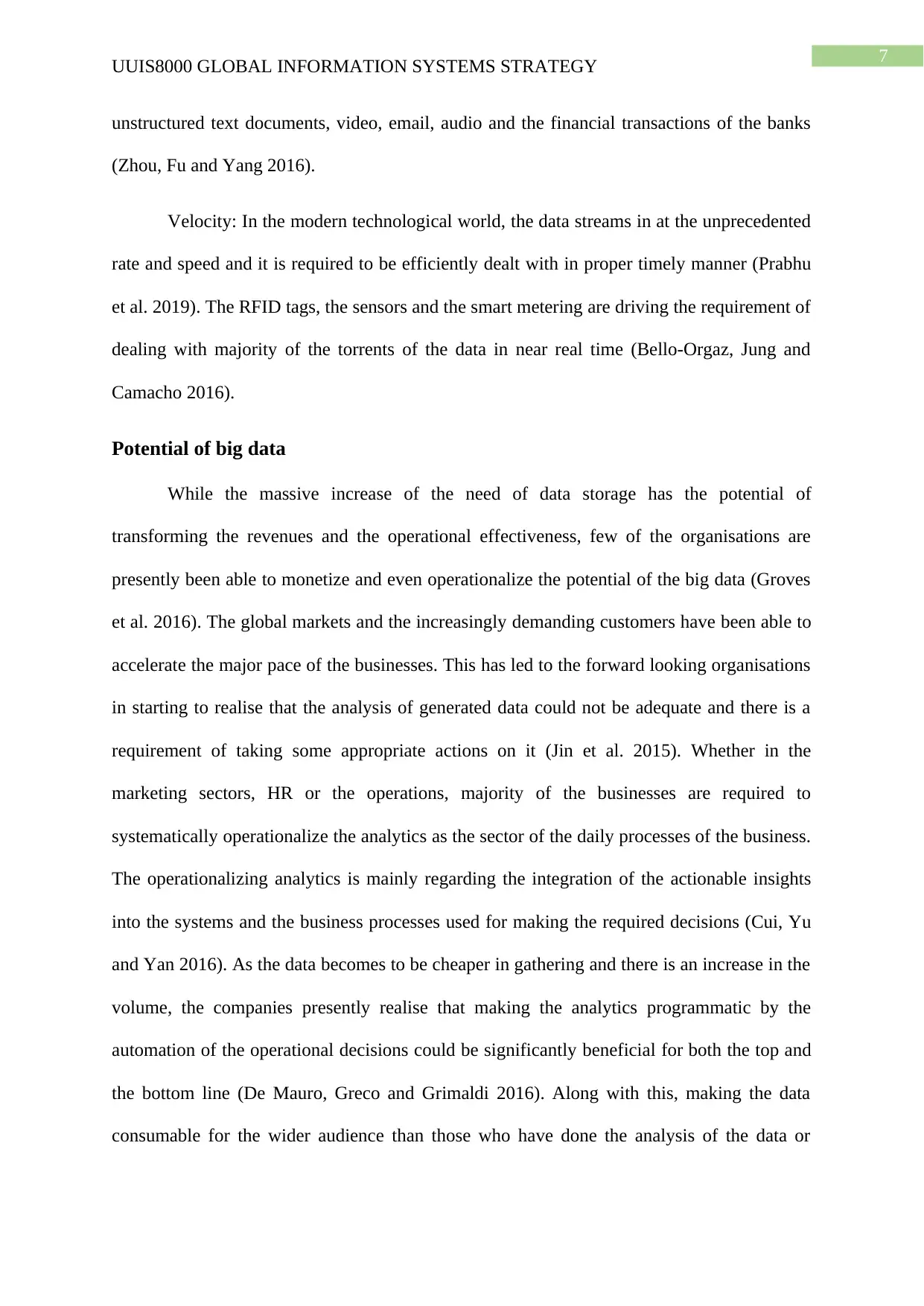
7
UUIS8000 GLOBAL INFORMATION SYSTEMS STRATEGY
unstructured text documents, video, email, audio and the financial transactions of the banks
(Zhou, Fu and Yang 2016).
Velocity: In the modern technological world, the data streams in at the unprecedented
rate and speed and it is required to be efficiently dealt with in proper timely manner (Prabhu
et al. 2019). The RFID tags, the sensors and the smart metering are driving the requirement of
dealing with majority of the torrents of the data in near real time (Bello-Orgaz, Jung and
Camacho 2016).
Potential of big data
While the massive increase of the need of data storage has the potential of
transforming the revenues and the operational effectiveness, few of the organisations are
presently been able to monetize and even operationalize the potential of the big data (Groves
et al. 2016). The global markets and the increasingly demanding customers have been able to
accelerate the major pace of the businesses. This has led to the forward looking organisations
in starting to realise that the analysis of generated data could not be adequate and there is a
requirement of taking some appropriate actions on it (Jin et al. 2015). Whether in the
marketing sectors, HR or the operations, majority of the businesses are required to
systematically operationalize the analytics as the sector of the daily processes of the business.
The operationalizing analytics is mainly regarding the integration of the actionable insights
into the systems and the business processes used for making the required decisions (Cui, Yu
and Yan 2016). As the data becomes to be cheaper in gathering and there is an increase in the
volume, the companies presently realise that making the analytics programmatic by the
automation of the operational decisions could be significantly beneficial for both the top and
the bottom line (De Mauro, Greco and Grimaldi 2016). Along with this, making the data
consumable for the wider audience than those who have done the analysis of the data or
UUIS8000 GLOBAL INFORMATION SYSTEMS STRATEGY
unstructured text documents, video, email, audio and the financial transactions of the banks
(Zhou, Fu and Yang 2016).
Velocity: In the modern technological world, the data streams in at the unprecedented
rate and speed and it is required to be efficiently dealt with in proper timely manner (Prabhu
et al. 2019). The RFID tags, the sensors and the smart metering are driving the requirement of
dealing with majority of the torrents of the data in near real time (Bello-Orgaz, Jung and
Camacho 2016).
Potential of big data
While the massive increase of the need of data storage has the potential of
transforming the revenues and the operational effectiveness, few of the organisations are
presently been able to monetize and even operationalize the potential of the big data (Groves
et al. 2016). The global markets and the increasingly demanding customers have been able to
accelerate the major pace of the businesses. This has led to the forward looking organisations
in starting to realise that the analysis of generated data could not be adequate and there is a
requirement of taking some appropriate actions on it (Jin et al. 2015). Whether in the
marketing sectors, HR or the operations, majority of the businesses are required to
systematically operationalize the analytics as the sector of the daily processes of the business.
The operationalizing analytics is mainly regarding the integration of the actionable insights
into the systems and the business processes used for making the required decisions (Cui, Yu
and Yan 2016). As the data becomes to be cheaper in gathering and there is an increase in the
volume, the companies presently realise that making the analytics programmatic by the
automation of the operational decisions could be significantly beneficial for both the top and
the bottom line (De Mauro, Greco and Grimaldi 2016). Along with this, making the data
consumable for the wider audience than those who have done the analysis of the data or
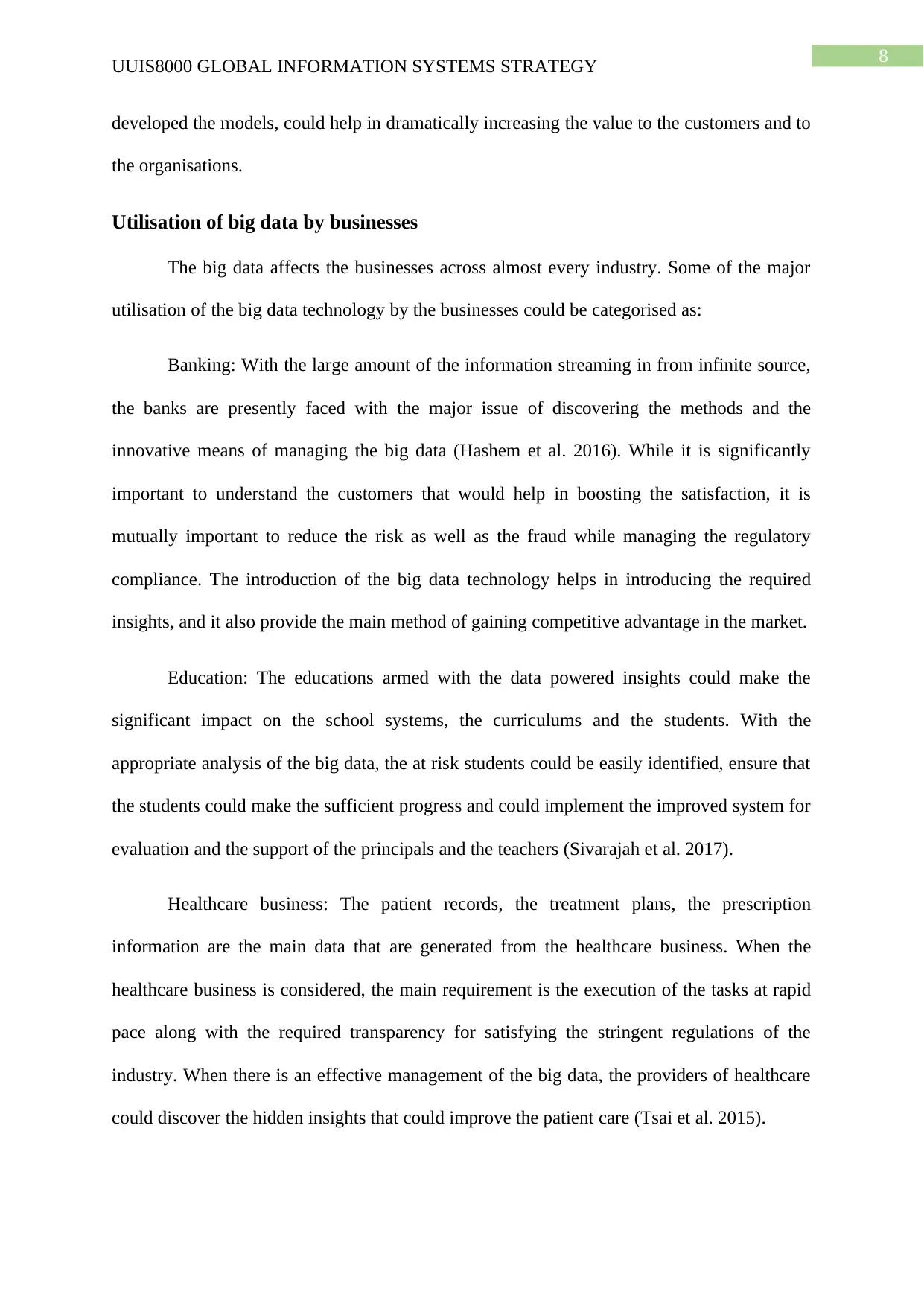
8
UUIS8000 GLOBAL INFORMATION SYSTEMS STRATEGY
developed the models, could help in dramatically increasing the value to the customers and to
the organisations.
Utilisation of big data by businesses
The big data affects the businesses across almost every industry. Some of the major
utilisation of the big data technology by the businesses could be categorised as:
Banking: With the large amount of the information streaming in from infinite source,
the banks are presently faced with the major issue of discovering the methods and the
innovative means of managing the big data (Hashem et al. 2016). While it is significantly
important to understand the customers that would help in boosting the satisfaction, it is
mutually important to reduce the risk as well as the fraud while managing the regulatory
compliance. The introduction of the big data technology helps in introducing the required
insights, and it also provide the main method of gaining competitive advantage in the market.
Education: The educations armed with the data powered insights could make the
significant impact on the school systems, the curriculums and the students. With the
appropriate analysis of the big data, the at risk students could be easily identified, ensure that
the students could make the sufficient progress and could implement the improved system for
evaluation and the support of the principals and the teachers (Sivarajah et al. 2017).
Healthcare business: The patient records, the treatment plans, the prescription
information are the main data that are generated from the healthcare business. When the
healthcare business is considered, the main requirement is the execution of the tasks at rapid
pace along with the required transparency for satisfying the stringent regulations of the
industry. When there is an effective management of the big data, the providers of healthcare
could discover the hidden insights that could improve the patient care (Tsai et al. 2015).
UUIS8000 GLOBAL INFORMATION SYSTEMS STRATEGY
developed the models, could help in dramatically increasing the value to the customers and to
the organisations.
Utilisation of big data by businesses
The big data affects the businesses across almost every industry. Some of the major
utilisation of the big data technology by the businesses could be categorised as:
Banking: With the large amount of the information streaming in from infinite source,
the banks are presently faced with the major issue of discovering the methods and the
innovative means of managing the big data (Hashem et al. 2016). While it is significantly
important to understand the customers that would help in boosting the satisfaction, it is
mutually important to reduce the risk as well as the fraud while managing the regulatory
compliance. The introduction of the big data technology helps in introducing the required
insights, and it also provide the main method of gaining competitive advantage in the market.
Education: The educations armed with the data powered insights could make the
significant impact on the school systems, the curriculums and the students. With the
appropriate analysis of the big data, the at risk students could be easily identified, ensure that
the students could make the sufficient progress and could implement the improved system for
evaluation and the support of the principals and the teachers (Sivarajah et al. 2017).
Healthcare business: The patient records, the treatment plans, the prescription
information are the main data that are generated from the healthcare business. When the
healthcare business is considered, the main requirement is the execution of the tasks at rapid
pace along with the required transparency for satisfying the stringent regulations of the
industry. When there is an effective management of the big data, the providers of healthcare
could discover the hidden insights that could improve the patient care (Tsai et al. 2015).
⊘ This is a preview!⊘
Do you want full access?
Subscribe today to unlock all pages.

Trusted by 1+ million students worldwide
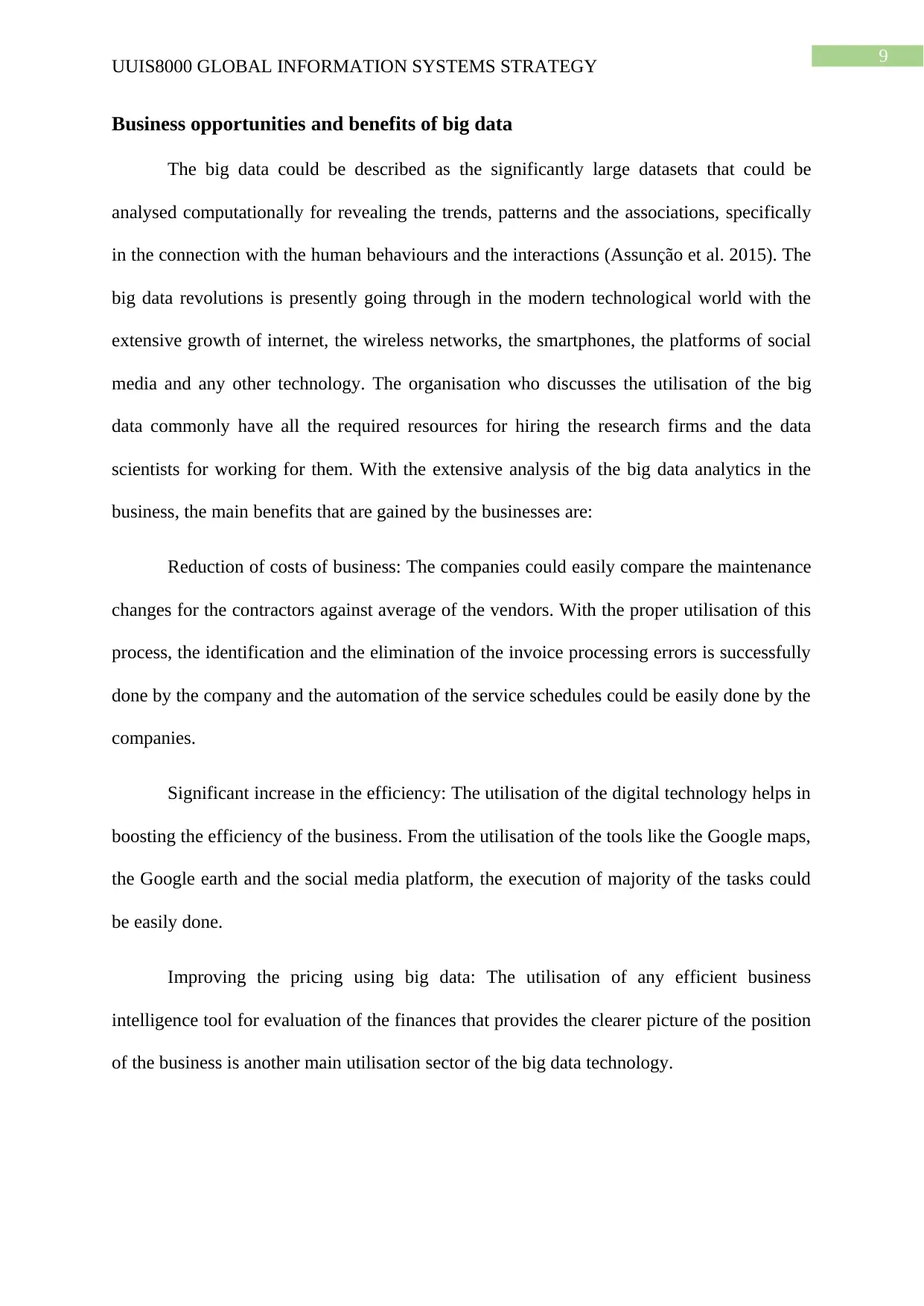
9
UUIS8000 GLOBAL INFORMATION SYSTEMS STRATEGY
Business opportunities and benefits of big data
The big data could be described as the significantly large datasets that could be
analysed computationally for revealing the trends, patterns and the associations, specifically
in the connection with the human behaviours and the interactions (Assunção et al. 2015). The
big data revolutions is presently going through in the modern technological world with the
extensive growth of internet, the wireless networks, the smartphones, the platforms of social
media and any other technology. The organisation who discusses the utilisation of the big
data commonly have all the required resources for hiring the research firms and the data
scientists for working for them. With the extensive analysis of the big data analytics in the
business, the main benefits that are gained by the businesses are:
Reduction of costs of business: The companies could easily compare the maintenance
changes for the contractors against average of the vendors. With the proper utilisation of this
process, the identification and the elimination of the invoice processing errors is successfully
done by the company and the automation of the service schedules could be easily done by the
companies.
Significant increase in the efficiency: The utilisation of the digital technology helps in
boosting the efficiency of the business. From the utilisation of the tools like the Google maps,
the Google earth and the social media platform, the execution of majority of the tasks could
be easily done.
Improving the pricing using big data: The utilisation of any efficient business
intelligence tool for evaluation of the finances that provides the clearer picture of the position
of the business is another main utilisation sector of the big data technology.
UUIS8000 GLOBAL INFORMATION SYSTEMS STRATEGY
Business opportunities and benefits of big data
The big data could be described as the significantly large datasets that could be
analysed computationally for revealing the trends, patterns and the associations, specifically
in the connection with the human behaviours and the interactions (Assunção et al. 2015). The
big data revolutions is presently going through in the modern technological world with the
extensive growth of internet, the wireless networks, the smartphones, the platforms of social
media and any other technology. The organisation who discusses the utilisation of the big
data commonly have all the required resources for hiring the research firms and the data
scientists for working for them. With the extensive analysis of the big data analytics in the
business, the main benefits that are gained by the businesses are:
Reduction of costs of business: The companies could easily compare the maintenance
changes for the contractors against average of the vendors. With the proper utilisation of this
process, the identification and the elimination of the invoice processing errors is successfully
done by the company and the automation of the service schedules could be easily done by the
companies.
Significant increase in the efficiency: The utilisation of the digital technology helps in
boosting the efficiency of the business. From the utilisation of the tools like the Google maps,
the Google earth and the social media platform, the execution of majority of the tasks could
be easily done.
Improving the pricing using big data: The utilisation of any efficient business
intelligence tool for evaluation of the finances that provides the clearer picture of the position
of the business is another main utilisation sector of the big data technology.
Paraphrase This Document
Need a fresh take? Get an instant paraphrase of this document with our AI Paraphraser
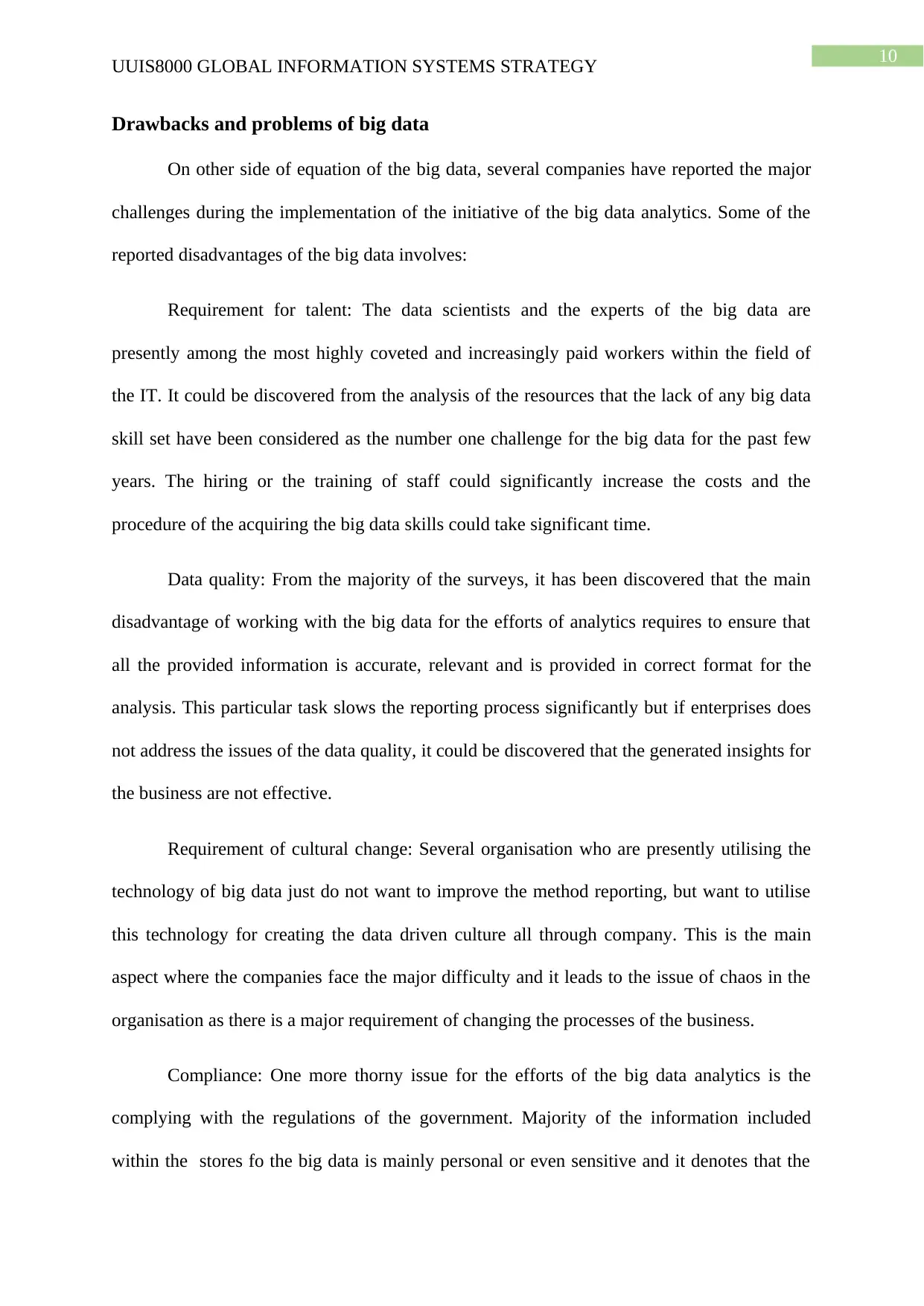
10
UUIS8000 GLOBAL INFORMATION SYSTEMS STRATEGY
Drawbacks and problems of big data
On other side of equation of the big data, several companies have reported the major
challenges during the implementation of the initiative of the big data analytics. Some of the
reported disadvantages of the big data involves:
Requirement for talent: The data scientists and the experts of the big data are
presently among the most highly coveted and increasingly paid workers within the field of
the IT. It could be discovered from the analysis of the resources that the lack of any big data
skill set have been considered as the number one challenge for the big data for the past few
years. The hiring or the training of staff could significantly increase the costs and the
procedure of the acquiring the big data skills could take significant time.
Data quality: From the majority of the surveys, it has been discovered that the main
disadvantage of working with the big data for the efforts of analytics requires to ensure that
all the provided information is accurate, relevant and is provided in correct format for the
analysis. This particular task slows the reporting process significantly but if enterprises does
not address the issues of the data quality, it could be discovered that the generated insights for
the business are not effective.
Requirement of cultural change: Several organisation who are presently utilising the
technology of big data just do not want to improve the method reporting, but want to utilise
this technology for creating the data driven culture all through company. This is the main
aspect where the companies face the major difficulty and it leads to the issue of chaos in the
organisation as there is a major requirement of changing the processes of the business.
Compliance: One more thorny issue for the efforts of the big data analytics is the
complying with the regulations of the government. Majority of the information included
within the stores fo the big data is mainly personal or even sensitive and it denotes that the
UUIS8000 GLOBAL INFORMATION SYSTEMS STRATEGY
Drawbacks and problems of big data
On other side of equation of the big data, several companies have reported the major
challenges during the implementation of the initiative of the big data analytics. Some of the
reported disadvantages of the big data involves:
Requirement for talent: The data scientists and the experts of the big data are
presently among the most highly coveted and increasingly paid workers within the field of
the IT. It could be discovered from the analysis of the resources that the lack of any big data
skill set have been considered as the number one challenge for the big data for the past few
years. The hiring or the training of staff could significantly increase the costs and the
procedure of the acquiring the big data skills could take significant time.
Data quality: From the majority of the surveys, it has been discovered that the main
disadvantage of working with the big data for the efforts of analytics requires to ensure that
all the provided information is accurate, relevant and is provided in correct format for the
analysis. This particular task slows the reporting process significantly but if enterprises does
not address the issues of the data quality, it could be discovered that the generated insights for
the business are not effective.
Requirement of cultural change: Several organisation who are presently utilising the
technology of big data just do not want to improve the method reporting, but want to utilise
this technology for creating the data driven culture all through company. This is the main
aspect where the companies face the major difficulty and it leads to the issue of chaos in the
organisation as there is a major requirement of changing the processes of the business.
Compliance: One more thorny issue for the efforts of the big data analytics is the
complying with the regulations of the government. Majority of the information included
within the stores fo the big data is mainly personal or even sensitive and it denotes that the
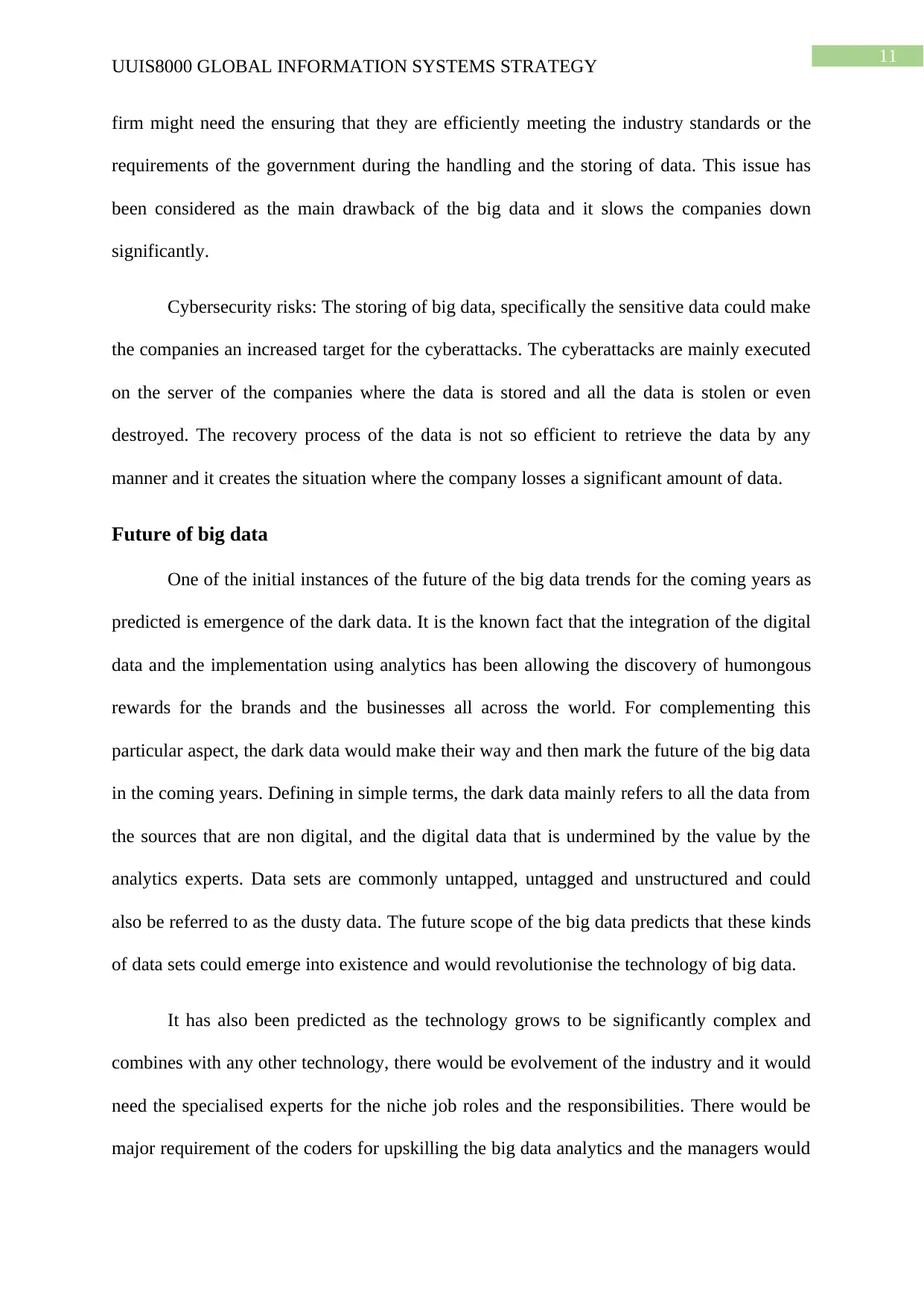
11
UUIS8000 GLOBAL INFORMATION SYSTEMS STRATEGY
firm might need the ensuring that they are efficiently meeting the industry standards or the
requirements of the government during the handling and the storing of data. This issue has
been considered as the main drawback of the big data and it slows the companies down
significantly.
Cybersecurity risks: The storing of big data, specifically the sensitive data could make
the companies an increased target for the cyberattacks. The cyberattacks are mainly executed
on the server of the companies where the data is stored and all the data is stolen or even
destroyed. The recovery process of the data is not so efficient to retrieve the data by any
manner and it creates the situation where the company losses a significant amount of data.
Future of big data
One of the initial instances of the future of the big data trends for the coming years as
predicted is emergence of the dark data. It is the known fact that the integration of the digital
data and the implementation using analytics has been allowing the discovery of humongous
rewards for the brands and the businesses all across the world. For complementing this
particular aspect, the dark data would make their way and then mark the future of the big data
in the coming years. Defining in simple terms, the dark data mainly refers to all the data from
the sources that are non digital, and the digital data that is undermined by the value by the
analytics experts. Data sets are commonly untapped, untagged and unstructured and could
also be referred to as the dusty data. The future scope of the big data predicts that these kinds
of data sets could emerge into existence and would revolutionise the technology of big data.
It has also been predicted as the technology grows to be significantly complex and
combines with any other technology, there would be evolvement of the industry and it would
need the specialised experts for the niche job roles and the responsibilities. There would be
major requirement of the coders for upskilling the big data analytics and the managers would
UUIS8000 GLOBAL INFORMATION SYSTEMS STRATEGY
firm might need the ensuring that they are efficiently meeting the industry standards or the
requirements of the government during the handling and the storing of data. This issue has
been considered as the main drawback of the big data and it slows the companies down
significantly.
Cybersecurity risks: The storing of big data, specifically the sensitive data could make
the companies an increased target for the cyberattacks. The cyberattacks are mainly executed
on the server of the companies where the data is stored and all the data is stolen or even
destroyed. The recovery process of the data is not so efficient to retrieve the data by any
manner and it creates the situation where the company losses a significant amount of data.
Future of big data
One of the initial instances of the future of the big data trends for the coming years as
predicted is emergence of the dark data. It is the known fact that the integration of the digital
data and the implementation using analytics has been allowing the discovery of humongous
rewards for the brands and the businesses all across the world. For complementing this
particular aspect, the dark data would make their way and then mark the future of the big data
in the coming years. Defining in simple terms, the dark data mainly refers to all the data from
the sources that are non digital, and the digital data that is undermined by the value by the
analytics experts. Data sets are commonly untapped, untagged and unstructured and could
also be referred to as the dusty data. The future scope of the big data predicts that these kinds
of data sets could emerge into existence and would revolutionise the technology of big data.
It has also been predicted as the technology grows to be significantly complex and
combines with any other technology, there would be evolvement of the industry and it would
need the specialised experts for the niche job roles and the responsibilities. There would be
major requirement of the coders for upskilling the big data analytics and the managers would
⊘ This is a preview!⊘
Do you want full access?
Subscribe today to unlock all pages.

Trusted by 1+ million students worldwide
1 out of 18
Related Documents
Your All-in-One AI-Powered Toolkit for Academic Success.
+13062052269
info@desklib.com
Available 24*7 on WhatsApp / Email
![[object Object]](/_next/static/media/star-bottom.7253800d.svg)
Unlock your academic potential
Copyright © 2020–2025 A2Z Services. All Rights Reserved. Developed and managed by ZUCOL.




